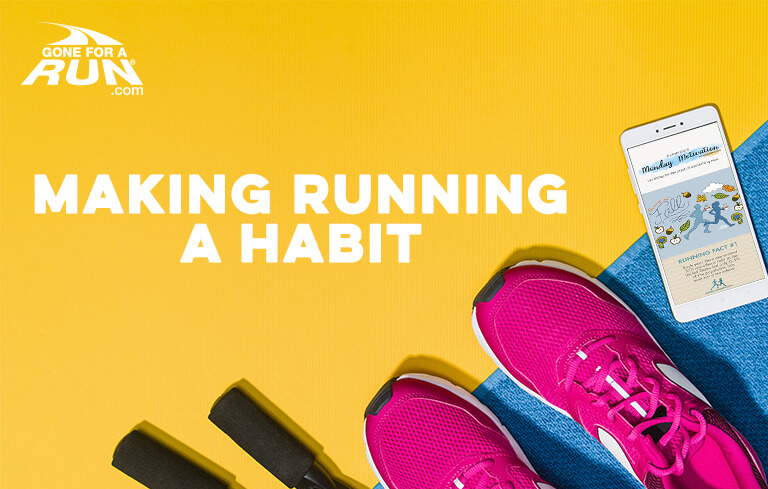ONLY $5.99 Shipping: Flat Rate Economy Shipping*
Free Shipping: Free Economy Shipping is available on orders over $100*
* Free Shipping is only available to valid addresses located in the contiguous U.S.
* Some exceptions apply
Come, run along with us as we share our joy of everything running.

Here at Gone For A Run, we consider running as a way of life. There are all kinds of runners: marathon runners, casual runners, experienced runners, beginning runners, returning runners, even runners who don’t like to run but do it because their friends do. Not everyone who aspires to the running life succeeds in being a habitual runner. So, we asked ourselves: what would we tell someone who wants to make running a habit? With that question in mind, we decided to combine our experiences and layout what we believe are the key elements to making running a lifestyle.
First, accept that it will take time to form the “running habit.”
Experts believe it takes between 3 to 8 weeks to create a new habit. During this crucial time, you’re creating new neural pathways that turn a conscious activity into something automatic, while deciphering how to naturally incorporate it into your life (so sticking with it is a realistic outcome). There is no “right amount” of time for how long it takes to form this habit, it depends on the individual. However. it is likely that around the 21-day mark, you’ll notice that it seems a little easier to go for your run; and, by the end of 8 weeks it will feel as much a part of your daily routine as eating or sleeping.
Then, Make a plan.
What is the best way to succeed during the first couple of months? Willpower can do only so much, so set yourself up for success with some preparation. Creating a running habit will go more smoothly and easily if you lay the groundwork and eliminate as many potential obstacles as possible in advance.
Recommendation: as with any athletic activity, before starting your running program visit your health care provider for a check-up to be sure that there are no physical impediments that would contraindicate running.

1. Make a list of what you will need.
The good thing about running compared to other sports is the basic equipment needed is minimal. If you are an on-again-off-again runner, you likely already have the right clothes, but maybe your running shoes are past their use-by date, or you are out of sunscreen. If you are a complete novice, get the basics – but (WARNING!) don’t let not having the latest performance tee-shirt delay you or be an excuse not to start. All you really need are:
A leading cause of injuries for novice and veteran runners alike is wearing worn or improperly-fitting shoes, so take the precaution of visiting a local running specialty store where you can get expert advice and invest in a well-fitting running shoe.
As long as you have these essentials you can get started. There are lots of fun and useful running items out there, which can be a fun incentive to reach goals and reward yourself down the road as you accomplish them.
2. Create a schedule.
Determine when and how often you will run. Put it in your calendar as an appointment so you don’t “accidentally” schedule something else. Resolve now that if you are invited for a social event during your scheduled run time, your answer will be “I’d love to, but I can’t, I already have plans” which is 100% true! If you are easily swayed, then practice saying it now-- so like running, it becomes a habit and automatically spills out of your mouth.
Don’t plan to run every day. Alternate run days with strength training, yoga, playing a sport, or any other physical activity to keep the momentum going, and take one or two days off a week to rest and recover. Tip: despite our best efforts, life really is unpredictable so plan for one make-up day each week in case something urgent does come up that can’t be avoided; then, be sure to honor the make-up day!
Keep it regular. Running or exercising at the same time every day makes it easier for it to become automatic. When choosing a time, stack the odds in your favor and choose a time of day when you are most likely to do it. For many, the best time is first thing in the morning before life interferes with your plans. If you are not a morning person or find exercising at the end of the day helps dissipate any built-up stress, then try the evening. Note: whether morning or evening, if it is dark be sure that you are prepared by wearing reflective material and an LED belt or hat light.
More: How To Feel Safer When You Run
3. Set goals.
First and foremost, choose an attainable goal.

4. Form a support system.
A good support system provides both encouragement and accountability in helping you achieve your goal. Try to incorporate as many of these as you can:
5. Devise a pre-run routine.
A pre-run routine will get you ready for your run both mentally and physically. Habits start with cues, which trigger behavior. Some ideas that others have found helpful:
Basically, the less thinking and preparing needed at the time you’ve scheduled your run, the less likely it is you will encounter some obstacle (even a small one!) that will keep you from going.
6. Decide on your rewards.
True, achieving the goal of making running a habit and all the health benefits that go along with it is a reward in itself. But until you get to that point, like training your dog you need to be rewarded for your good behavior. Your post-run reward is as important as your pre-run routine to successfully create a habit. Come up with a list of rewards that will motivate you:
Whatever you choose, be sure to reward yourself immediately after the run to reinforce the behavior.
Likewise, it’s also a good idea to choose a few rewards in advance for hitting milestones such at the end of the first week, after finishing the first 21 days, and when you have hit the 8-week mark. These can be something small like a new running headband, or more significant such as a new tech tee or a pair of recovery sandals .
7. Enjoy the run.
Running is 90% mental, so make the run itself as enjoyable as possible – play your favorite upbeat music or use it as time to listen to a podcast or audiobook. When you buy new running gear pick items you love in colors that make you happy so you will feel good in them. Choose scenic routes and pay attention to the scenery around you whether city or country.
If you follow these tips you will be on your way to creating a running habit. Just remember that runners are not made overnight. You’re human so there may be days or weeks when you aren’t meeting your planned goal. That’s ok, but instead of beating yourself up or worse, giving up, just get back on the road the next day. Once it becomes a habit it becomes automatic, feels easier, and eventually becomes a new way of life. Welcome to the club!